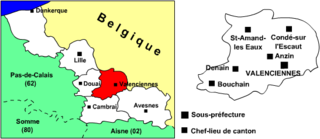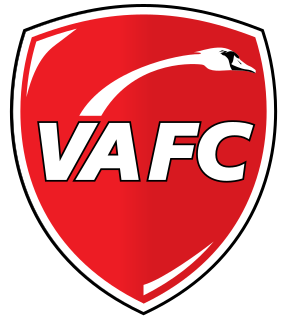
Valenciennes is a commune in the Nord department in northern France.

The Merry Widow is an operetta by the Austro-Hungarian composer Franz Lehár. The librettists, Viktor Léon and Leo Stein, based the story – concerning a rich widow, and her countrymen's attempt to keep her money in the principality by finding her the right husband – on an 1861 comedy play, L'attaché d'ambassade by Henri Meilhac.

Epinephelus is a genus of fishes in the family Serranidae found in Atlantic, Indian, and Pacific Oceans.

Jean-Louis Borloo is a French politician and was the leader of the Union of Democrats and Independents, and French Minister for Ecology, Energy, Sustainable Development and Town and Country Planning between 2007 and 2010. On 6 April 2014, he announced in a letter that he would resign from every mandate or responsibility, due to health reasons.

The arrondissement of Valenciennes is an arrondissement of France in the Nord department in the Hauts-de-France region. It has 82 communes.

Valenciennes Football Club is a French association football club based in Valenciennes. The club was founded in 1913 and currently play in Ligue 2, the second tier of French football. Valenciennes plays its home matches at the recently built Stade du Hainaut located within the city.

The Valenciennes tramway is a tram system serving Valenciennes and part of its surrounding areas, in the Nord department of France. Since 2014 the network consists of two lines with a total of 33.8 mi (54.4 km) of track and 48 stations.

The Battle of Famars was fought on 23 May 1793 during the Flanders Campaign of the War of the First Coalition. An Allied Austrian, Hanoverian, and British army under Prince Josias of Saxe-Coburg-Saalfeld defeated the French Army of the North led by François Joseph Drouot de Lamarche. The action occurred near the village of Famars in northern France, five km south of Valenciennes.

Cephalopholis is a genus of fish in the family Serranidae. It contains the following species:
The Ligue 2 season 2005–06, organised by the LFP was won by Valenciennes FC and saw the promotions of Valenciennes FC, CS Sedan Ardennes and FC Lorient, whereas AC Ajaccio, RC Strasbourg and FC Metz were relegated from Ligue 1.

The Polytechnic University of Hauts-de-France, previously known as University of Valenciennes and Hainaut-Cambrésis until 1 January 2018, is a French public university, based in Valenciennes. It is under the Academy of Lille and is a member of the European Doctoral College Lille-Nord-Pas de Calais and of the Community of Universities and Institutions (COMUE) Lille Nord de France. On a national scale, in terms of graduate's employability, the university ranks from 1st to 68th out of 69 universities. In the field of legal training, economics and management, 99% of the university's graduates are employed. Overall, the University is ranked 28th out of 73 universities in France.

Valenciennes lace is a type of bobbin lace which originated in Valenciennes, in the Nord département of France, and flourished from about 1705 to 1780. Later production moved to Belgium in and around Ypres. The industry continued onto the 19th century on a diminished scale. By the 19th century valenciennes lace could be made by machine.

Snappers are a family of perciform fish, Lutjanidae, mainly marine, but with some members inhabiting estuaries, feeding in fresh water. The family includes about 113 species. Some are important food fish. One of the best known is the red snapper.

Ariël Jacobs is a Belgian former footballer last manager of Ligue 1 side Valenciennes FC

The 21st constituency of the Nord is a French legislative constituency in the Nord département.

Lethrinus nebulosus is a species of emperor fish. Common names include spangled emperor, green snapper, morwong, north-west snapper, sand bream, sand snapper, sixteen-pounder, and yellow sweetlip.
Réginald Ray is a French former footballer and currently head coach of Valenciennes in Ligue 2. He was also an assistant manager of both Aston Villa in the Premier League and Bastia.
Van der Hoeven's organ is the infrabuccal lamellar organ in the adult male of genus Nautilus. It consists of a pair of fleshy narrow parallel lobes each containing 15-19 lamellae. It is analogous to Owen's laminated organ of the females, which is also infrabuccal and also lamellar, though females have an additional secondary sexual organ, the organ of Valenciennes. It along with the spadix and antispadix comprise the secondary sexual organs of the male. Its function has been described as possibly olfactory, but since its discovery in the mid nineteenth century its exact function, like that of its counterpart, has never been adequately explained— this is why it remains named after the naturalist who first described it rather than having an organ name like "heart" or "gill".
















